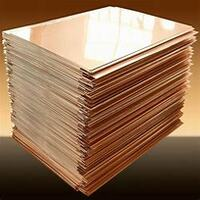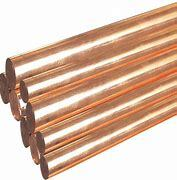1. Introduction
In the past 48 hours, the London Metal Exchange reported a 2.3% surge in copper prices, driven by increased demand from electric vehicle and renewable energy infrastructure projects. This spike highlights copper’s critical role in modern technology—and puts products like the copper rod squarely in the spotlight. Whether you’re an electrician, welder, plumber, or scrap recycler, understanding the versatility and value of copper rod is essential.

Copper rod—also referred to as rod copper—is a foundational material in countless industries. From grounding systems to welding and plumbing, its high conductivity, corrosion resistance, and malleability make it indispensable. In this article, we’ll break down everything you need to know about copper rod, including its types, applications, pricing, and how it connects to related copper products like strips and pipes.
2. What Is a Copper Rod?
A copper rod is a solid, cylindrical bar made from high-purity copper, typically produced through continuous casting or extrusion. It serves as a raw material for electrical conductors, grounding systems, welding consumables, and more. Depending on the application, copper rods can be pure electrolytic tough pitch (ETP) copper or alloyed with elements like beryllium or nickel for enhanced mechanical properties.
Common terms you’ll encounter include copper round bar and round bar copper—both referring to the same product. These rods are available in various diameters and lengths, tailored to specific industrial needs.
3. Types of Copper Rods and Their Uses
Not all copper rods are created equal. Here’s a breakdown of the most common types:
- Copper earth rod and earthing rod copper: Used in electrical grounding systems to safely dissipate fault currents into the earth. These are often made from solid copper or copper-bonded steel for cost efficiency.
- Copper bonded earthing rod and copper bonded ground rod: Feature a steel core coated with a thick layer of copper (typically 0.25mm or more). They offer the strength of steel with the conductivity and corrosion resistance of copper.
- Copper clad ground rod and copper clad steel earth rod: Similar to bonded rods but use metallurgical bonding or electroplating. Terms like copper clad earth rod and copper clad steel ground rod are often used interchangeably in procurement specs.
- Copper brazing rod and copper to copper brazing rods: Used in joining copper components without melting the base metal. Ideal for HVAC and plumbing repairs.
- Copper welding rod, copper rod for welding, and copper to copper welding rod: Designed for fusion welding of copper parts. Welding rod copper types vary by alloy composition to match the base metal’s properties.
4. Copper Rod Pricing Trends

The copper rod price fluctuates with global markets, but as of mid-2024, it averages $8,500–$9,200 per metric ton. For specialized products like earthing rod price or copper bonded variants, costs depend on copper thickness, length, and certification standards.
Buyers often compare copper bonded vs. solid copper rods—while solid copper offers superior longevity, copper bonded steel provides a cost-effective alternative for many grounding applications. Always verify conductivity and corrosion resistance specs before purchasing.
5. Copper Rod vs. Copper Strip and Other Forms
While copper rod is cylindrical, copper strip (also called copper stip, copper stripes, or copperstrip) is flat and thin—ideal for busbars, earthing straps, and electronics. Products like flat copper strip, 1mm copper strip, and beryllium copper strip serve niche roles in high-performance applications.
You’ll also see nickel plated copper strip for enhanced solderability or corrosion resistance, and flexible copper bus bar for dynamic electrical connections. For grounding, copper strip for earthing—such as the common copper earth strip 25x3mm—is widely used in substations.
If you’re sourcing locally, searches like ‘copper strip near me’ or ‘roll of copper strip’ can help locate suppliers. Prices vary, but copper strip price typically reflects purity, thickness, and whether it’s sold in coil or cut lengths.
6. Recycling and Wire Stripping Tips
Scrap recyclers often deal with stripping copper wire to recover pure metal. The best way to strip copper wire depends on volume: manual strippers for small jobs, rotary machines for bulk, and industrial shredders for large-scale operations.

Avoid burning copper wire for scrap—it’s illegal in many areas and releases toxic fumes. Instead, use the fast way to strip copper wire with mechanical tools. Whether you’re stripping wire for scrap or recycling, always prioritize safety and environmental compliance.
7. Connection to Copper Piping Systems
Though distinct from rod forms, copper pipework shares the same base material. Air conditioning copper pipe (also called aircon copper pipe or ac copper pipe) is essential in HVAC systems. Sizes like 15mm copper pipe, 22mm copper tube, and 3/4 copper tubing are standard in residential and commercial installations.
Professionals often solder copper pipe using copper pipe soldering techniques, and rely on copper pipe fittings and connectors for leak-free joints. Pricing for ac copper pipe price or air conditioner copper pipe price varies by diameter and wall thickness (Type L vs. Type M).
8. Related Copper Products: Bars, Ingots, and Busbars
Beyond rods and strips, copper bars—including copper flat bar, flexible copper bar, and copper bus bar—are vital in power distribution. Cu bars and copper bars for sale come in various tempers and dimensions, with applications from switchgear to battery terminals.
Copper ingot and copper ingot price matter to foundries and refiners, while 1oz copper price is tracked by investors. For DIY or industrial use, knowing where to source quality copper bar top or round bar copper ensures project reliability.
9. Where to Buy and What to Watch For
When purchasing copper rod or related products, verify material certifications (e.g., ASTM B3 for electrical copper). Compare copper rod price across suppliers, but don’t sacrifice quality for minor savings—especially for critical applications like earthing or welding.
For grounding, ensure your earthing rod copper meets local electrical codes. In high-corrosion environments, solid copper or thick copper bonded steel is preferable over thin copper clad steel ground rod options.
10. Conclusion
From copper rod welding in fabrication shops to copper earth rod installations in solar farms, this versatile material powers modern infrastructure. With copper prices on the rise and sustainability driving recycling efforts, understanding the full spectrum of copper products—from rod to strip to pipe—is more valuable than ever. Whether you’re installing, repairing, or recycling, choosing the right copper form ensures performance, safety, and cost-efficiency.
Our Website founded on October 17, 2012, is a high-tech enterprise committed to the research and development, production, processing, sales and technical services of ceramic relative materials such as 10. Our products includes but not limited to Boron Carbide Ceramic Products, Boron Nitride Ceramic Products, Silicon Carbide Ceramic Products, Silicon Nitride Ceramic Products, Zirconium Dioxide Ceramic Products, etc. If you are interested, please feel free to contact us.

